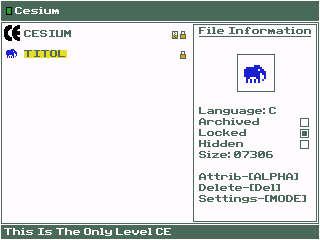- This Is The Only Level +CE
- 11 Sep 2016 05:13:59 pm
- Last edited by JWinslow23 on 11 Sep 2016 11:05:24 pm; edited 1 time in total
I've decided to take up C for the CE (thank you, Mateo  ). My first game will be This Is The Only Level. You know, like this one.
). My first game will be This Is The Only Level. You know, like this one.
I've gotten done with the tilemapper. Here's a gif of the current progress:

Download is here.
There are a couple of questions I want answered, though, so the development process can go as quickly as possible.
1. What's "sprite clipping" and should I use it?
2. For some odd reason, the gfx_TransparentSprite() routine leaves the tile sprites normal when drawn slightly off-screen, but the player sprite entirely disappears when he is off-screen even one pixel. Why is that, and how do I fix it?
3. The "random" colors for the background and spikes look like different shades of blue for some reason. Am I doing it wrong, or is there bias in the random numbers?
4. Are there any more conventions and things that can make my programming life easier?
EDIT: Fixed random color generation so a proper color is output.
I've gotten done with the tilemapper. Here's a gif of the current progress:

Download is here.
There are a couple of questions I want answered, though, so the development process can go as quickly as possible.
1. What's "sprite clipping" and should I use it?
2. For some odd reason, the gfx_TransparentSprite() routine leaves the tile sprites normal when drawn slightly off-screen, but the player sprite entirely disappears when he is off-screen even one pixel. Why is that, and how do I fix it?
3. The "random" colors for the background and spikes look like different shades of blue for some reason. Am I doing it wrong, or is there bias in the random numbers?
4. Are there any more conventions and things that can make my programming life easier?
EDIT: Fixed random color generation so a proper color is output.















